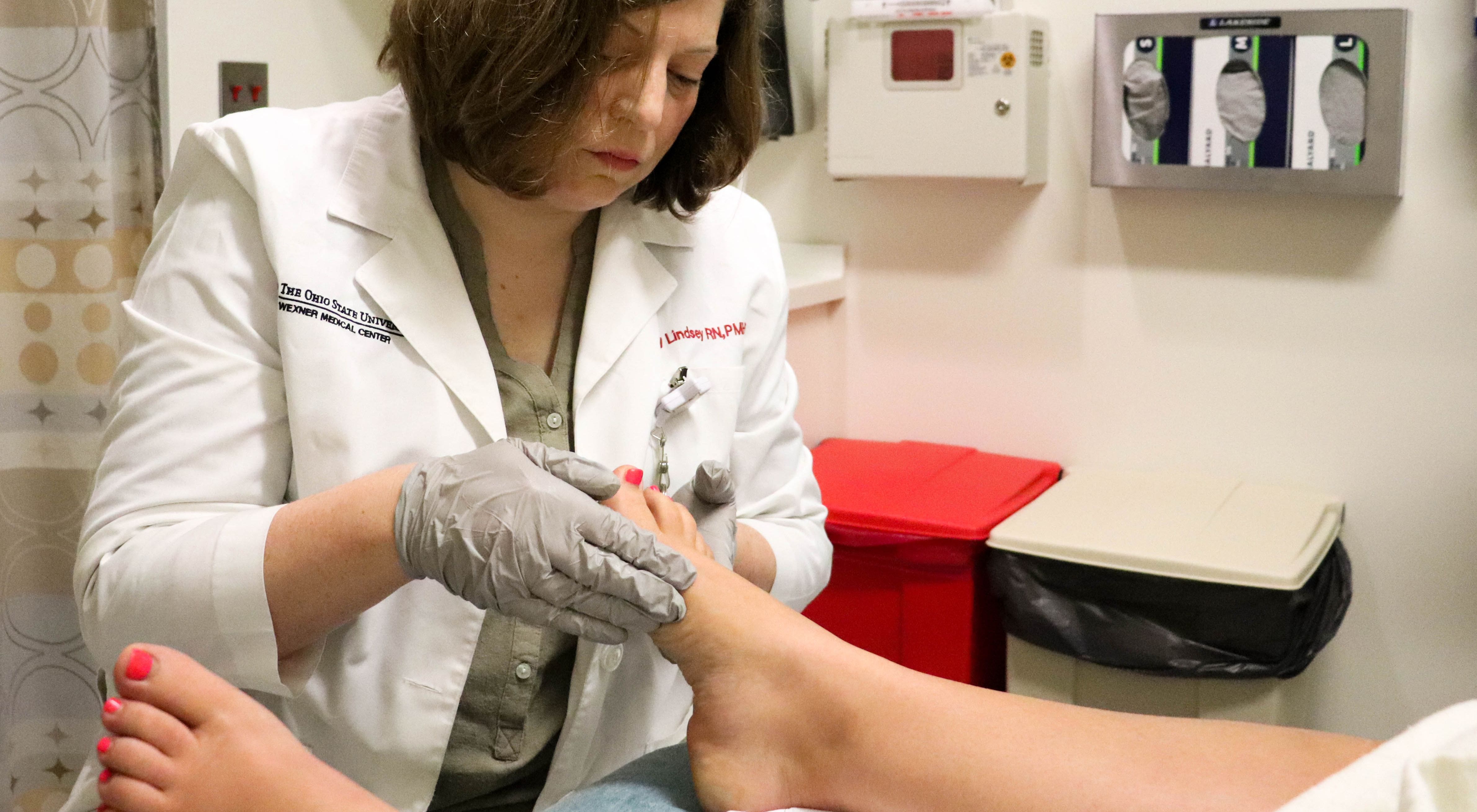Article
Aromatherapy and Reflexology Drastically Reduce Pain, Anxiety in Cervical Cancer Treatment
Author(s):
Non-pharmacologic integrative medicine approaches such as aromatherapy and reflexology can dramatically reduce the pain and anxiety associated with cervical radiation therapy, according to a clinical study currently underway at The Ohio State University Comprehensive Cancer Center – Arthur G. James Cancer Hospital and Richard J. Solove Research Institute (OSUCCC – James).
Amy Lindsey performs foot reflexology on a patient with cervical cancer. A new study at The Ohio State University Comprehensive Cancer Center - Arthur G. James Cancer Hospital and Richard J. Solove Research Institute found that, along with aromatherapy, reflexology reduced patients' use of pain medications by 40 percent during brachytherapy sessions.

Amy Lindsey performs foot reflexology on a patient with cervical cancer. A new study at The Ohio State University Comprehensive Cancer Center - Arthur G. James Cancer Hospital and Richard J. Solove Research Institute found that, along with aromatherapy, reflexology reduced patients' use of pain medications by 40 percent during brachytherapy sessions.
Non-pharmacologic integrative medicine approaches such as aromatherapy and reflexology can dramatically reduce the pain and anxiety associated with cervical radiation therapy, according to a clinical study currently underway at The Ohio State University Comprehensive Cancer Center — Arthur G. James Cancer Hospital and Richard J. Solove Research Institute (OSUCCC – James).
In an interview with CURE, Lisa Blackburn, MS, APRN, clinical oncology nurse specialist at The OSUCCC — James and principal investigator of the study, discussed how the study came to be and what it means for patients with not just cervical cancer, but other types of cancer as well.
Standard radiation treatment touches everything it passes through, which can damage healthy tissue. Brachytherapy is an alternative that spares normal tissue by using an implanted device to focus the radiation as close to the tumor as possible. However, this treatment comes with a downside, particularly in cervical cancer, Blackburn said.
In fact, previous studies have shown that up to 40 percent of women experienced such significant anxiety and pain because of cervical radiation therapy that they developed post-traumatic stress disorder.
To see if aromatherapy and reflexology could mitigate this anxiety, Blackburn and her team randomly assigned 50 women undergoing brachytherapy to one of two groups: a control group and an experimental group that received aromatherapy with three essential oils to choose from (peppermint, lavender and lemon), in an adjustable fan diffuser, along with a 30-minute foot reflexology session during the downtime after the device was placed and before treatment.
Researchers first measured each patient’s baseline anxiety level on a scale of 0 to 10, then measured pain and re-checked anxiety levels five times throughout the treatment when both were shown to be highest: upon arrival to the procedure area; at applicator placement; after placement and before treatment; during treatment; and finally during the applicator removal.
The researchers then averaged each patient’s score and factored in the amount of pain and anxiety medication they required throughout treatment. When comparing the control group to the experimental group, the researchers reported preliminary results that show a 60 percent reduction in reported pain, along with a 20 percent decrease in anxiety.
When asked why aromatherapy and reflexology are so effective in reducing these negative side effects, Blackburn says the answer is simple: “They relax people.” “Whether you’re having symptoms or not, the [aromatherapy and reflexology] make you feel better, especially in these patients.”
In addition to avoiding another pill or procedure, these noninvasive tools also help to distract patients and give them a sense of control, Blackburn added.
“A lot of times with cancer patients, we virtually take all of their control away, especially when they’re in active treatment. And this is something that, as we’re doing it, we’re teaching it to them.”
While more research is needed on all integrative therapies, Blackburn is hopeful they can become a standard of care in a broader patient base. “I’ve been doing studies for a long time and it looks to me like they could absolutely be used in any patient with cancer,” she said.
“I really think that, in the end, any patient that is offered an opioid for pain management should also be offered integrative therapies. If we’re giving them pharmacological interventions, we ought to give them the benefit of at least introducing them to the non-pharmacological options.”




